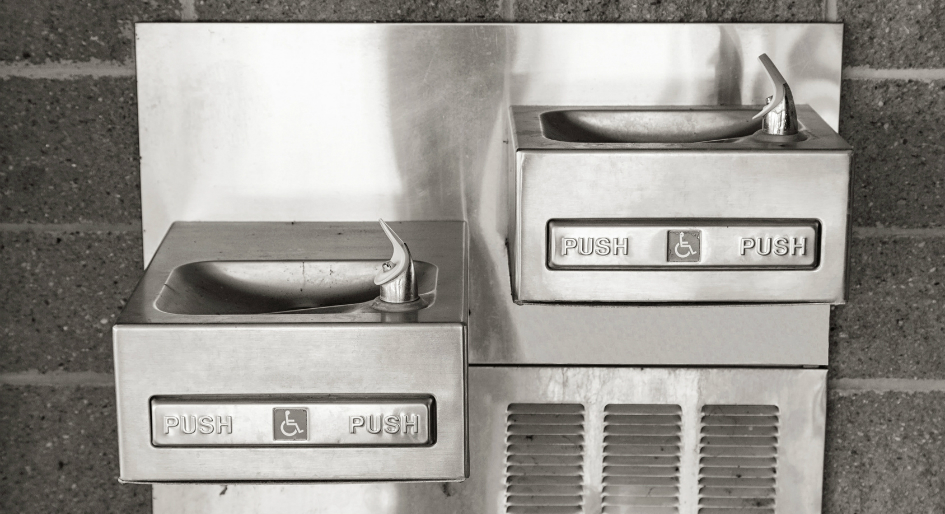Many schools across North America are failing government-mandated lead level tests. It’s not unique to a single geography; schools in big cities, suburbs, and rural areas are equally affected.
School administrators are required to flush their plumbing systems regularly in order to keep lead levels low. Flushing is needed because lead was widely used as a soldering element in pipes until 1986, and some plumbing systems installed before 1975 may have lead pipes, according to the Government of Canada. In both cases, lead from corrosion can contaminate water that passes through the pipes, especially if the water is hot. Water that has been sitting in pipes for six or more hours or over extended periods of time such as weekends, holidays, and especially over the summer break, is more likely to be contaminated. Lead is difficult to trace in drinking water because it carries no odour, taste or smell.
According to Health Canada, it is normal for Canadians to be exposed to low levels of lead. Food and drinking water are among the most common routes for lead to enter the body, in part owing to lead plumbing fixtures, according to the CMA Journal. Blood lead levels have decreased by more than 70 per cent over the last 30 years, but lead is still commonly detected in the Canadian population.
Lead exposure for children is of particular concern. According to KidsHealth, lead is a neurotoxin associated with several health risks, including damage to the central nervous system and learning disabilities, among others. Additionally, children’s bodies are more likely to absorb and retain lead than adults’. Ultimately, there is no “safe” amount of lead for children to consume.
Risk management is imperative for protecting children’s health. Regular pipe flushing is a standard practice and required by law to help keep lead at safe levels. Without a national system for collecting data and monitoring lead poisoning in children, facility managers and administrators can take a leadership role in ensuring lead levels are safe throughout their schools by monitoring lead flushing on a continuous basis.
Traditionally, the frequency of flushing was tracked manually, if at all, sometimes resulting in spotty records and a lack of insight into proper lead flushing. Otherwise, monitoring required sizeable investments in invasive plumbing infrastructure to track water flow.
More recently, IoT technology has made available commercial-grade, low-cost options for managing the process. Sensors that affix to water meters and do not require technical or plumbing knowledge can be used to make smart water-flow monitoring a collective effort.
By monitoring water flow minute by minute, school facility managers and administrators can ensure that essential lead flushing is being performed, and also quantify the length of each flushing event. For example, to flush the plumbing at a school, the Government of Ontario recommends staff turn on “the last tap/faucet (not a fountain) on each run or branch of plumbing, and let the water run for at least five minutes.” Running times differ depending on rate of flow and how far the water taps are from the water main on the street as well as the plumbing fixture involved, and age of building. A refrigerated water fountain requires 15 minutes of flushing, for example.
It’s possible to track lead flushing by manually recording flush times and durations on a spreadsheet that is shared with school administrators, but this method has its potential shortcomings, as mentioned earlier. Real-time water usage data can be used to avoid lead flushing that is either too short, and therefore ineffective, or too long, thus resulting in high water bills and water waste.
When water usage is tracked automatically, historical data and analytics can be used to create a consumption profile for each school and establish a benchmark for normal water use across all buildings in the district to help determine when unusual activity occurs. Smart sensors can also send mobile or email alerts for leaks, floods, unusual water usage, pipe freezing, power outages and humidity levels to help protect school buildings 24/7 from water damage as well as aid administrators in utility management and conservation efforts.
Facilities and maintenance departments can and should take proactive measures to ensure lead flushing is being performed effectively in order to meet legal and health requirements within their schools and across districts.
George Tsintzouras is CEO and co-founder of Alert Labs, a Kitchener, Ontario-based company that produces intelligent leak detection devices. George graduated from the University of Waterloo with his Bachelor of Physics and entered the field of optics. He earned his Master of Business Administration (MBA) degree from Wilfrid Laurier University, with a specialization in marketing strategy.




